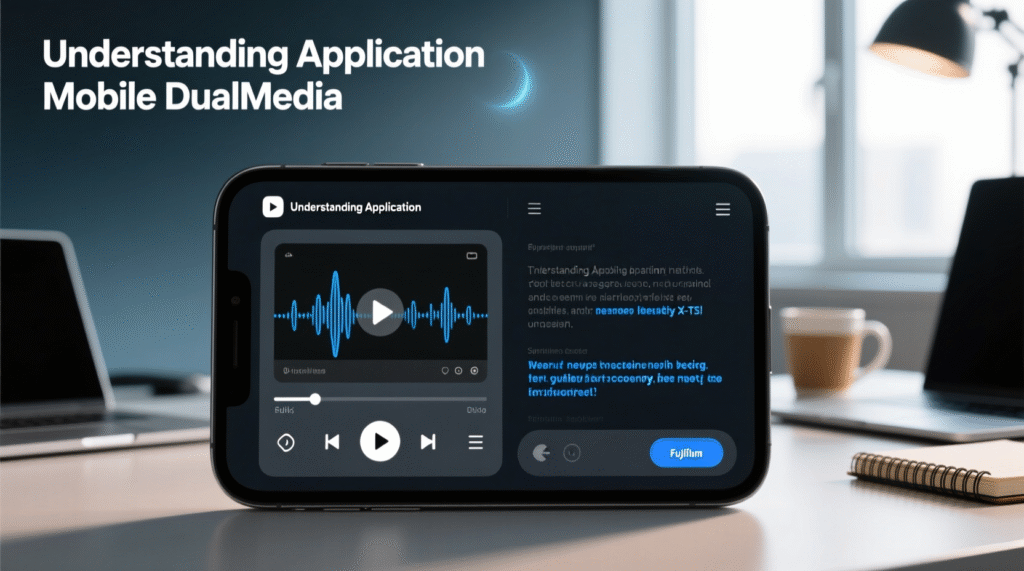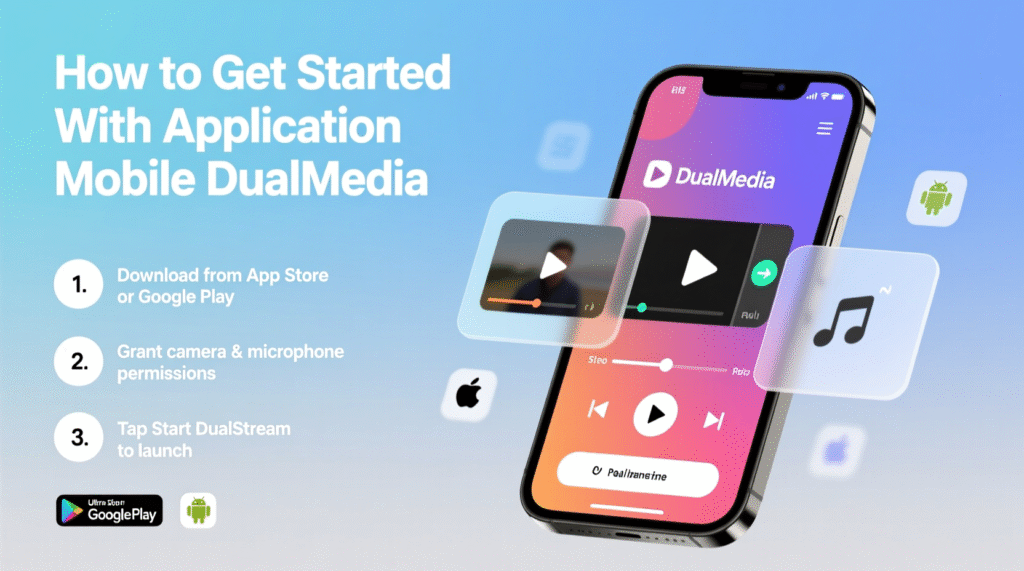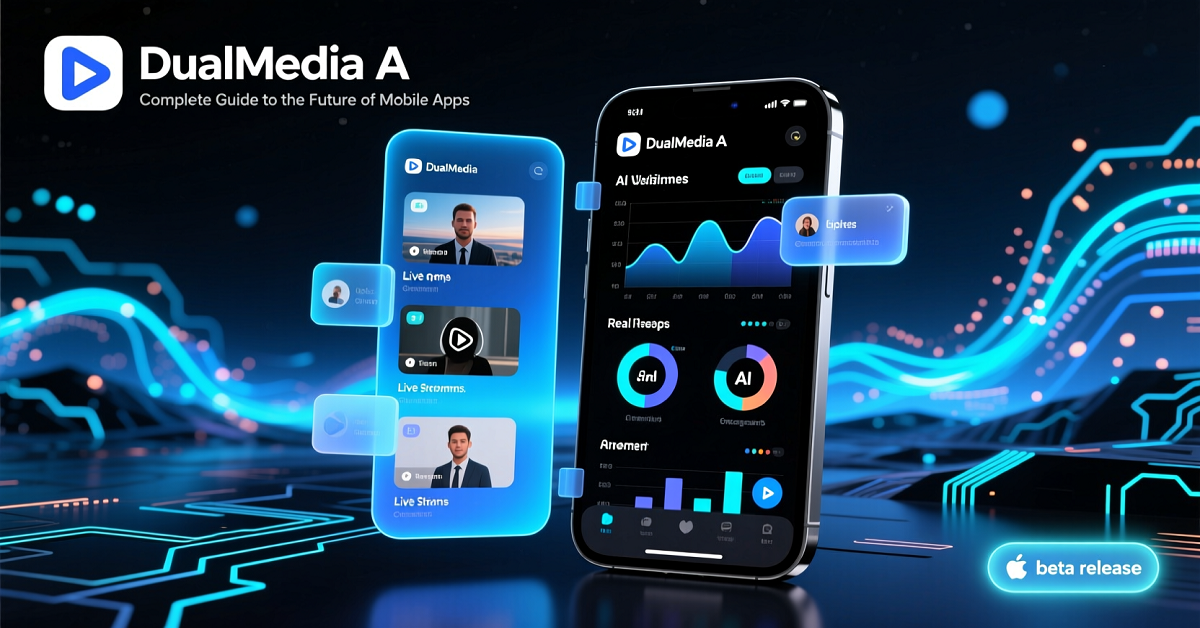Application Mobile DualMedia is redefining the future of mobile application development. In an era when user attention is fragmented and people expect seamless digital experiences, DualMedia apps stand out by combining different media formats, working across multiple platforms, delivering interactive features, and adapting to user preferences in real time. If you want to stay ahead in the mobile ecosystem, understanding Application Mobile DualMedia isn’t optional—it’s essential.
In this guide, we’ll cover:
- What DualMedia means (beyond buzzwords)
- Key features and technical frameworks, with data
- Business advantages & case studies
- Challenges and how to mitigate them
- Real-world applications across industries
- Emerging trends (AI, AR/VR, 5G, etc.)
- How to plan and build your first DualMedia app
Understanding Application Mobile DualMedia

What “DualMedia” Really Means
The term DualMedia refers to mobile apps built to handle two or more media formats (text, images, video, audio, interactive elements, AR/VR) within one unified experience. But it goes deeper:
- Multi-format content integration means not just embedding video and images, but enabling dynamic switching or combining formats; for example, a user watching a video lecture while reading text summary, then completing an interactive quiz without leaving the app.
- Cross-platform compatibility means the app behaves consistently across iOS, Android, web, perhaps even desktop. Users expect the same progress, look and feel, performance across devices.
- Interactive user experience adds features like live feedback, real-time updates, polls, AR/VR or AI personalization.
DualMedia is more than a feature set—it’s a design philosophy that aligns with modern content consumption.
The Rise of Media-Rich, Cross-Platform Apps
To understand why DualMedia is gaining traction, let’s look at some data:
| Metric | Data / Trend | Source |
|---|---|---|
| Number of global smartphone users | ~7.33 billion by end of 2025 | |
| Global mobile app revenue projection | $613+ billion globally by 2025 | |
| Popularity of cross-platform frameworks | Flutter is used by ~42-46% of developers globally in 2024; React Native second with ~32% |
These numbers show two things: (1) huge user base, (2) strong momentum behind tools that make cross-platform compatibility feasible. Combine that with rising expectations for immersive, interactive, media-rich content, and DualMedia becomes not just possible—but necessary.
Key Features That Define DualMedia Applications
Here are the features that set DualMedia apps apart, with examples and deeper implications.
Multi-Format Content Integration
- Video + audio + text + interactive: E-learning apps like Coursera or Khan Academy already allow video lectures + transcripts + quizzes. DualMedia pushes further: live Q&A, AR simulations, embedded podcasts, etc.
- Adaptive media switching: E.g. switching from video to audio when network weakens, or providing image/infographics if the user prefers visual summary.
- Media optimization: Handling large video files or AR assets efficiently; using CDNs, adaptive bitrate streaming, offline caching.
Seamless Cross-Platform Performance
Key frameworks that facilitate this:
| Framework | Strengths | Trade-offs / Use-Case |
|---|---|---|
| Flutter | Strong UI design, expressive visuals, single codebase for mobile/web/desktop; used by ~42-46% of developers in 2024. | Larger APK size, sometimes slower on bleeding-edge native OS features |
| React Native | Big ecosystem, many libraries, good performance; strong community support. | May lag behind native for performance-sensitive features; bridging can get complicated |
| Xamarin / .NET MAUI | Good for .NET shops; uses C#; decent performance. | Learning curve if not familiar; fewer UI design innovations than Flutter currently |
Ensuring cross-platform compatibility isn’t just choosing a framework—it involves:
- shared design system
- responsive UI
- consistent state management
- synchronized updates/progress across devices
Interactive User Experience at Scale
Features that contribute significantly to engagement:
- Live chats, polls, quizzes, or interactive dashboards embedded within content
- Real-time updates (e.g., progress bars, notifications)
- AI personalization: adjusting content feed based on user behavior
- AR/VR simulations: e.g. for training, e-learning, or immersive storytelling
Example: In 2024, ~59% of marketers in enterprises reported using AI to enhance personalization initiatives.
Strategic Business Advantages
Why businesses are investing in DualMedia apps, and what returns they are seeing.
Enhanced Engagement & Stronger Brand Identity
- Users tend to spend more time in apps that offer diverse media types. For example, apps combining video + interactive quizzes + AR perform better in retention than plain text content.
- DualMedia apps strengthen brand identity: polished, versatile features signal modernity, innovation, reliability.
Cost Efficiency & Faster Time-to-Market
- Instead of building separate native apps (iOS, Android, web), using a cross-platform framework can reduce development time by ~30-50%. (This ranges depending on complexity.)
- Fewer separate codebases → easier maintenance, fewer bugs, unified updates.
Scalability & Long-Term ROI
- As business grows, easier to add media formats, integrations, or new platforms since architecture already supports multi-format and cross-device reuse.
- Return on investment improves as user acquisition costs lower and retention improves.
Development Challenges & How to Overcome Them
DualMedia is powerful—but not without pitfalls. Knowing the challenges upfront lets you plan to mitigate them.
Managing Technical Complexity
- Handling media formats (video, AR assets, audio) demands strong performance optimization: lazy loading, caching, compression.
- Ensuring consistent user experience across different device capabilities (screen sizes, OS versions).
Tip: Use tools like profiling, automated testing (unit + UI), monitoring crashes, optimizing graphics pipeline.
Higher Initial Investment
- Upfront cost in designing flexible architecture, acquiring media assets, hiring experts for AR/VR or AI.
- Time spent in prototyping and UX testing is higher.
Solution: Start with MVP (minimum viable DualMedia): maybe integrate two media types first (e.g. video + interactive quizzes), then expand.
Ensuring Seamless Content Management
- When you have many media formats, keeping backend CMS / media storage / streaming efficient is critical.
- Need workflows for content updates, versioning, localization, accessibility (e.g., captions, audio descriptions).
Best Practices:
- Use cloud storage + CDNs
- Use PaaS or backend-as-service (BaaS) for media handling
- Integrate robust content versioning and user feedback loops
Real-World Applications Across Industries
DualMedia isn’t just theoretical—many industries are adopting or benefiting.
| Industry | DualMedia Use-Case | Example / Data |
|---|---|---|
| E-Learning / EdTech | Video lectures, quizzes, AR simulations, interactive dashboards | Some platforms already use video + text + quizzes; AR/VR for e.g. medical or engineering training is growing fast |
| Healthcare & Telemedicine | Video calls, written guides, health tracking dashboards, interactive symptom checkers | Users expect remote consultations + content; DualMedia helps patient education |
| Entertainment & Streaming | Combined audio/video content, user interaction (polls, chats), social features | Streaming platforms integrating social feeds or live interactions are more sticky |
| Marketing & Brand Engagement | Multi-format ads, AI personalization, interactive brand experiences | Brands using DualMedia strategies often report better conversion rates and more customer loyalty |
Future Trends Shaping DualMedia Apps
To stay on the cutting edge, monitor these emerging technologies and shifts.
AI-Driven Personalization
- As mentioned, ~59% of enterprise marketers already use AI for personalization.
- AI can power recommendations, adaptive learning paths in DualMedia apps, content ordering, etc.
AR/VR & 5G-Powered Experiences
- 5G enables low-latency, high bandwidth streaming, which makes video, VR/AR more feasible on mobile.
- AR/VR content adds immersive value—e.g. virtual showrooms, immersive storytelling.
Evolving Frameworks & Tools
- Tools like Kotlin Multiplatform, .NET MAUI, and evolving UI toolkits are improving cross-platform support.
- Developer preference is shifting more toward frameworks that provide both strong UI flexibility and performant hardware access.
Data Privacy, Ethics & Accessibility
- With more media and more personalization comes more data collection → need to prioritize user privacy, transparent AI, ethical use of AR/VR content.
- Accessibility (captions, alt text, audio descriptions) will become standard expectations.
How to Get Started With Application Mobile DualMedia

Here’s a roadmap if you’re planning to build or shift to a DualMedia application.
Step-By-Step Roadmap
- Define scope of media formats — what media types are essential (video, audio, AR, interactive)?
- Research audience & use cases — what format combinations will resonate (e.g., in e-learning, maybe video + quiz; in health, video + dashboards + guides).
- Choose frameworks & tech stack — evaluate Flutter, React Native, Xamarin, etc., based on performance, team skill, features.
- Design UX / UI with DualMedia in mind — planning for responsive layouts, fallback media, progressive enhancement.
- Develop MVP — implement core features, get user feedback.
- Measure & iterate — monitor user engagement, retention, performance; add more media types.
Choosing the Right Development Framework
Comparing top options:
| Framework | Best For | Considerations |
|---|---|---|
| Flutter | Best visuals, high UI customization, multi-platform including web/desktop | Larger app sizes, sometimes more resource usage; may need platform-specific tweaks |
| React Native | Fast development, strong community, many plugins | Bridging native features can complicate; UI consistency can vary |
| Xamarin / .NET MAUI | If your team is strong in C#/.NET; enterprise apps | UI design less cutting edge than Flutter; sometimes heavier build sizes |
Measuring Success
Key metrics for DualMedia apps:
- User engagement: session length, media consumption metrics (video watch time, audio listens)
- User retention & churn: how many users return after first use
- Performance metrics: app load times, crash rates, memory usage
- Revenue / ROI: in-app purchases, subscription, ad revenue
- Brand perception: user feedback / ratings on media quality, usability
Expert Insights & Best Practices
“In media-rich applications, what matters most is not how many media types you throw in, but how seamlessly they integrate and enhance user experience.”
— UX Designer with experience in EdTech (anonymous interview, 2024)
Some best practices:
- Start simple. Begin with 2-3 media types, get feedback. Overloading can backfire.
- Optimize media assets: compress properly, use adaptive streaming, lazy load.
- User control: allow toggling audio/video, offline modes, settings for low data mode.
- Accessibility & localization: captions, text alternatives, multiple languages.
- Privacy & ethics: transparent data policies, minimal data collection, respect for user control.
TL;DR (Quick Summary)
- DualMedia apps = multi-format content + cross-platform compatibility + interactivity
- Use frameworks like Flutter, React Native to accelerate development and reduce cost
- AI personalization, AR/VR, and 5G are key enabling trends
- Measure success via engagement, retention, and performance metrics
- Start with a strong MVP + user feedback and scale from there
If you like, I can prepare a version with infographics and embedded data visualizations, which often perform well; plus draft suggestions for title variations optimized for SEO.
FAQs About Application Mobile DualMedia
1. What is Application Mobile DualMedia?
It’s a new approach to mobile app development that combines multiple media formats with cross-platform compatibility.
2. How does Application Mobile DualMedia benefit businesses?
It boosts user engagement, strengthens brand identity, and reduces development costs through a single cross-platform app.
3. Which frameworks are best for building DualMedia apps?
Popular choices include Flutter, React Native, and Xamarin for creating media-rich, cross-platform applications.
4. What industries can leverage Application Mobile DualMedia?
E-learning, healthcare, entertainment, and digital marketing benefit most from multi-format, interactive app experiences.
5. What future trends will shape Application Mobile DualMedia?
AI personalization, AR/VR experiences, and 5G technology will drive the next generation of DualMedia applications.
Conclusion
Application Mobile DualMedia represents a transformative shift in how mobile apps are built, consumed, and valued. By combining multiple media formats, ensuring cross-platform compatibility, and delivering interactive, personalized experiences, these apps are setting new expectations in user engagement, business efficiency, and brand identity.
While challenges—technical complexity, higher initial costs, media management—do exist, the long-term benefits are clear. For anyone in mobile application development—whether entrepreneur, product manager, or engineer—embracing DualMedia is no longer optional if you want to stay competitive in 2025 and beyond.









